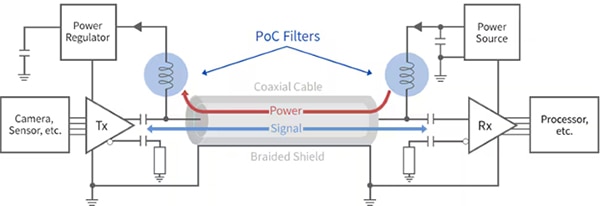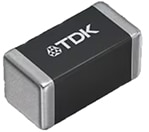多层电感器是汽车 PoC 应用的必备器件
投稿人:DigiKey 北美编辑
2025-01-14
在高速公路上行驶的新型中高端车很可能使用了同轴供电电缆 (PoC) 组件,用于传输高带宽电子系统所需的电源和数据,并减小布线复杂性和整体重量。随着信息娱乐和驾驶辅助应用在市场上的普及,即使是成本较低的汽车也开始采用 PoC 技术。
现在,美国市场上所有的车辆,无论价格高低,都必须配备倒车影像和自动紧急制动系统。PoC 布线提供了一种更简单、更具性价比的方法,通过一根电缆同时传输电力和数据(图 1)。通过减轻重量,该技术有助于提高汽油车的燃油效率和电动汽车 (EV) 的续航里程。简化电缆组件还有助于减少安装和维护所需的时间和人力,节省材料成本,并在制造商的产品线中推广。
 图 1:典型的 PoC 传输系统。(图片来源:TDK Corporation)
图 1:典型的 PoC 传输系统。(图片来源:TDK Corporation)
然而,在单根同轴电缆中结合信号和电源本身就会产生噪声,因此汽车 PoC 应用需要高阻抗滤波电感器来确保复杂电子系统的运行可靠性。适当的阻抗匹配对避免电压下降、功率损耗和数据损坏至关重要,这些情况都可能对车辆行驶产生不利影响。
多层电感器能够确保纯净地传输信号,实现无噪声,因此越来越不可或缺。这种电感器具有高电感和高阻抗以及非常紧凑的外形,可满足汽车制造商增加车载电子设备以节省空间的需求。
PoC 如何满足汽车应用需求
PoC 简化了通过单根电缆传输电力和数据的过程,以更少的组件节省材料成本,并减少了潜在故障点。
该技术更易于扩展,以支持更多的功能,这一点至关重要,因为装配商正在争先恐后地为信息娱乐系统和安全系统增加更多的传感器和其他电子设备,包括越来越复杂的高级驾驶辅助系统(ADAS)。高端车正在超越强制要求,以采用高级功能,如二级自动驾驶、360 度摄像头视角以及自动平行和垂直泊车。
这就要求具有处理高速数据传输、高分辨率视频和实时通信能力。PoC 的高带宽、高频率能力对于高级车辆系统的实施至关重要,这些系统越来越依赖多传感器融合、5G 连接、集中式计算架构和边缘计算能力。PoC 可支持汽车行业标准,如 FPD-Link III(每链路最高 4 Gbps)和汽车以太网传输(最高 10 Gbps)。
汽车应用在设计时必须符合各项严格的标准。当涉及到来自常见汽车中的高频源,如点火系统和电机的电磁干扰 (EMI)时更应如此。EMI 噪声可能会干扰基本的安全和信息娱乐系统,而这些系统有助于驾驶者避免倒车碰撞,保持在车道内行驶,并在前方出现车辆、行人或其他障碍物挡路时减速或停车。
屏蔽式同轴电缆可在一定程度上防止电磁干扰,但由于 PoC 同时传输电源和数据信号,因此在应用中需要使用滤波器来防止串扰和潜在的系统不稳定性。信号线一侧的电容器用于阻止来自直流电源的电流,电源线上的滤波电感器可防止宽带信号干扰。
电源线上的滤波电感器在允许直流电流通过的同时阻断干扰信号,从而抑制噪声并确保信号完整性。此外,表面贴装式片状磁珠还能抑制 EMI、减少串扰并提供局部滤波。
片状磁珠和滤波电感器一起工作,以确保通过单根同轴电缆无缝地传输电源和高频数据信号。每个组件都在管理噪声和保持信号完整性方面发挥着互补作用。这对于确保纯净的电力传输和稳定的数据通信极其重要,而对于 PoC 汽车应用的可靠性和效率来说则是必备条件。
电感器在 PoC 系统中的作用
标准的线圈型电感器可用于阻断电源线上的高频数据信号,同时允许直流通过,但这种电感器可能体型较大,而且在 PoC 应用所需的高频范围内性能较差。典型的 PoC 滤波器由四个电感器和片状磁珠组成,占用了印刷电路板 (PCB) 上的宝贵空间。
多层电感器的外形高度紧凑,更适合汽车应用中空间有限的需求。多层电感器通过堆叠导电和绝缘材料层形成紧凑的整体结构,因此非常适合用于汽车系统。
在选择最佳多层电感器时,产品设计者必须在性能、尺寸和可靠性之间进行取舍,以确保高效的功率传输和数据完整性。PoC 系统中的高频数据信号需要电感器在较宽的频率范围内始终保持高阻抗(通常为 MHz 至 GHz),以有效抑制噪声。低直流电阻 (DCR) 对于减少功率损耗也至关重要,尤其是在电动汽车等应用中。
设计者应考虑噪声环境,并决定将多层电感器与片状磁珠配对使用,以增强 EMI 抑制能力。一个多层电感器和两个片状磁珠可以取代上述四电感器组合,从而大大减少所需的 PCB 面积。
用于 PoC 应用的多层电感器专为满足严格的汽车标准而设计(如 AEC-Q200),具有出色的高频 EMI 抑制能力。这些产品采用先进的生产工艺,可根据大批量汽车制造的需要进行扩展。
TDK 的 MLJ-G 系列电感器
TDK Corporation 提供各种用于滤波电路的电感器,以满足汽车 PoC 应用的严格要求。 MLJ-G 系列包括两个产品组,均具有高阻抗功能,适用于 ADAS 中使用的交流元件,并提供满足不同应用的选项。这些电感器按照汽车级规格制造,坚固耐用,能够承受车辆行驶期间常见的冲击,且使用寿命长。
较新的 MLJ1005-G 系列电感器,如 MLJ1005WGHR27PTD25(图 2)的尺寸为 1.0 mm × 0.5 mm × 0.5 mm。这些电感器支持高达 480 mA 的电流,能在高频率下实现高阻抗,同时将降额情况降到最低,从而能够适应汽车 PoC 实施过程数据传输速度的提高,例如使用 SerDes 传输技术的摄像头系统。
 图 2:TDK MLJ-1005-G 系列电感器。(图片来源:TDK Corporation)
图 2:TDK MLJ-1005-G 系列电感器。(图片来源:TDK Corporation)
MLJ1608-G 系列电感器的尺寸稍大,为 1.6 mm × 0.8 mm × 0.8 mm,在尺寸和性能之间取得了平衡。例如,MLJ1608WGCR56NTD25 可支持高达 500 mA 的电流,与传统的多层电感器相比,其在通电过程中的阻抗变化更小。
MLJ1608-G 系列的最大阻抗为 2,500 Ω,在 300 MHz 至 2 GHz 的频率范围内可保持 1,000 Ω 以上的水平,从而能有效过滤高频噪声。该系列能在机械振动和 -55°C 至 +125°C 的温度范围内可靠运行,符合汽车行业标准。
MLJ-G 产品线采用低损耗铁氧体材料,可吸收和分散 EMI,以确保将能量耗散降至最低,这对于在汽车的高频环境中保持信号完整性至关重要。由于直流电阻小,这些器件能最大限度地减少能量损耗,即使在紧凑型高性能汽车设计中也能确保高效的功率传输。
片状磁珠与电感器配对使用
设计人员可以通过选择与 MLJ-G 系列电感器相辅相成的降噪型片状磁珠来增强汽车 PoC 应用。
TDK 的 MMZ 系列片状磁珠用于信号和电源电路。该系列在较宽的频率范围内具有高阻抗,因此适于抑制高频噪声。MPZ 系列针对汽车电源线应用进行了优化,具有低直流电阻和大电流处理能力,可在 PoC 电路中保持电源的完整性。
结语
TDK 的 MLJ-G 系列电感器以及 MMZ 和 MPZ 系列片状磁珠专为满足汽车 PoC 应用的严格要求而设计,能在制造商不断增加依赖高频信号和高带宽的安全和信息娱乐应用的同时,确保运行可靠和信号完整。

免责声明:各个作者和/或论坛参与者在本网站发表的观点、看法和意见不代表 DigiKey 的观点、看法和意见,也不代表 DigiKey 官方政策。






